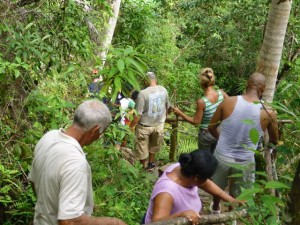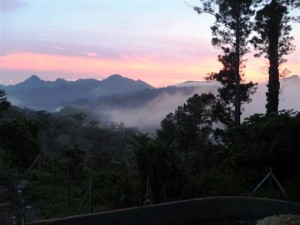
A German rediscovers Cuban regions
A hiker’s diary
The mystery is not in the relation between the Cheops pyramid and El Escambray
By Otto Wolfgang
(Photos by R.H.Kravets)
HAVANA – I must start by confessing that I decided to undertake this excursion after reading several esoteric writings that claim that the meridian that goes through the great Pyramid of Cheops in Egypt and divides the world in two equal halves passes through Cuba, specifically through the mountain range called El Escambray in the center of the island.
As a natural accident, that area is not a challenge for someone who has scaled major heights in Europe, but for an island in the Caribbean to have the privilege to appear among the mysteries of such an ancient culture was enough of a prod for someone, like me, who likes oddities and challenges.
I read that information in a book by Walter Blomquist that deals with that exceptional fact, along with other stories about the wall paintings in the Punta del Este cave in the former Isle of Pines, to which Blomquist attributes an astronomic significance.
I also became acquainted with theories that the Cuban archipelago was part of the submerged and mythical Atlantis or broke away from the Yucatán peninsula, where the mega-meteorite that caused the disappearance of the dinosaurs allegedly fell. The well-known Bermuda Triangle is also nearby.
For someone who, while traveling through this battered planet has come across inexplicable events and presences, such theories are not foolish. Although I recognize some oversimplification in many of them, I feel prompted to prove them. And because I speak Spanish, and Cuba in other ways called loudly (for better or for worse) and was one of my latest experiences, I decided to visit it a second time.
Ignoring the captivating environment of Old Havana, which I later enjoyed with unforgettable fruition, and not because I’m a countryman of Alexander von Humboldt but because we Germans are curious and restless, I went straight toward Cienfuegos. Along the southern coastal highway, I came across the tree-filled landscape of Topes de Collantes.
 “Civilized” lodging can be found everywhere, in comfortable lodgings or in the Kurthotel, where you can be treated for stress or vitiligo or even baldness. But I was looking for “one of the maximum circles of the terrestrial sphere that go through the two poles,” a definition of the word “meridian” that I found in the Spanish Royal Academy’s dictionary, ever present in my backpack for obvious reasons.
“Civilized” lodging can be found everywhere, in comfortable lodgings or in the Kurthotel, where you can be treated for stress or vitiligo or even baldness. But I was looking for “one of the maximum circles of the terrestrial sphere that go through the two poles,” a definition of the word “meridian” that I found in the Spanish Royal Academy’s dictionary, ever present in my backpack for obvious reasons.
I opted for environmental tourism to decipher the truth and fable of this mountain range called Guamuahaya by the natives. The system allows you to spend the nights in the open air or in occasional rustic buildings. Well-trained guides who speak several languages can guide you with ease, allowing you to feel alone or accompanied, as you prefer.
Because some hikers like to take pictures to show at home and others pretend to be naturalists, the exquisite conservation of these protected areas allows us to appreciate a great variety of species of fauna and flora that are infrequent in zones outside the tropics.
A microclimate with temperatures between 16 and 25 degrees Celsius yearlong (although in 1958 the temperature dropped to below zero, according to the locals) and a moderate humidity allow the growth of tall eucalyptus trees and various pine trees, some of them as tall as 100 meters and as wide as 3.6 meters in diameter.
One hundred species of birds have been recorded in the area, among them 45 percent of all the birds endemic in Cuba. Reportedly, parrots have reproduced remarkably there, after being almost extinguished by human predators.
As a mountain climber, I saw few possibilities to climb the thick forest but as I went along I came across simple monuments, reminders that farmers or teachers had been killed here and there. I even found a marker in memory of Félix Rodríguez de la Fuente, a Spanish naturalist who hosted the TV series “Man and Nature.”
Had he been there? I asked. No, was the answer, but his fellow adventurers felt that this was the right place to honor his memory.
Topes de Collantes is in the province of Sancti Spiritus. It is 19 kilometers from Trinidad, the third village founded by the Spaniards, but does not need such credentials to be special.
The arborescent ferns stand out with serene elegance along any road or up the steepest paths. I learned about carob trees, cedars, mahogany, magnolias and teak while climbing or descending from smooth hillsides or while I watched the afternoon rain fall, densely, rhythmically, in an orgasmic silence.
The illusory path
While asking myself about the mystery that brought me to these latitudes, I ran across the cave called El Altar, former home and refuge for slaves and field workers in the years when a Catalonian (I was told) founded a coffee plantation at a height where the clouds go through trees and approach the people as if to ask them or warn them about something. I had never before found clouds to be as daring and amiable as I did then.
The plantation house, its furnishings and pictures were left there by Codina, the founder. The plantation itself is one of the protected parks in the 110-kilometer-square area of Topes, as the locals call it.
El Altar is an impressive hollow rock that could be the transept of a gothic cathedral. It has a secret passageway that leads to a balcony from which you can see the Valle de los Ingenios and even the peninsula of Ancón.
According to the promotional leaflets, this area is 800 meters above sea level, but one of our companions said that Potrerillo, near Codina, is 900 meters above sea level. As he said that, he pointed to the old sanatorium for lung diseases, visible below.
That building – today the Kurthotel – was constructed in the mid-1950s. Some locals say that it was the wife of dictator Fulgencio Batista who convinced her husband to build it, because she had tuberculosis and felt sorry for those who also had it.
Another version says that it was a simple act of charity by the First Lady, who liked the landscape so much that she ordered a small palace to be built there, diverting the course of a tributary of the Vega Grande River and building a dam that became her private pool.
The local residents tell that story without rancor. Today, the site is called La Represa (The Dam) and has been turned into a public entertainment center with an arboretum that has 300 exotic varieties of trees.
Another site, El Caburní, has a crystal-clear, 62-meter waterfall. It’s nothing spectacular for those of us who have been around, but it has an almost magical charm. Swimming in its reservoirs, I experienced relief of pains that I didn’t even know I carried in my soul.
They say that the lakes in the cavern system of La Batata have curative powers. They say the same about the mud in Codina, where you also find a suggestive collection of orchids. The restaurant in Codina prepares tasty meals with firewood.
Colín, a spring that flows downhill from a cave, is home to a frog by the same name. The tiny amphibian is one of the world’s smallest. I didn’t get to see the white-tailed deer but was assured that it lives in that region.
Vegas Grande is another high spot, with very steep hillsides, difficult to climb and to descend. It may be the only one of the six parks in Topes to require some skill in climbing, although I did see children and elderly people climb the 650 meters to reach the highest waterfall in the region.
For reasons I mustn’t make public, toward the end of my trek I went to the Turk-Escambray Hotel. Frankly, when I entered the grand lobby, I turned around, walked away and changed my clothing. The clothes I wore on the paths and slippery secondary roads were not appropriate for this place, decorated with masterpieces of Cuban art, boasting a level of hygiene bordering on obsessive, and a group of specialists in specialized therapies who were so qualified that they seemed to have come from another galaxy.
Because I also walked through traditional hamlets, isolated farms, neighborhoods with new and impersonal mien, plantations of greens and flowers, and because I hiked through half the country, seeing a great many things and talking with the island’s multicolored human mosaic, I realized that the Egypt-Cuba connection did not involve perfect geomagnetic parallels – even if they do exist.
* German-born Otto Wolfgang, a teacher of Spanish, was kind enough to collaborate with Progreso Weekly by sharing with us his travel journal in the form of an article.
Progreso Semanal/ Weekly authorizes the total or partial reproduction of the articles by our journalists, so long as source and author are identified.


